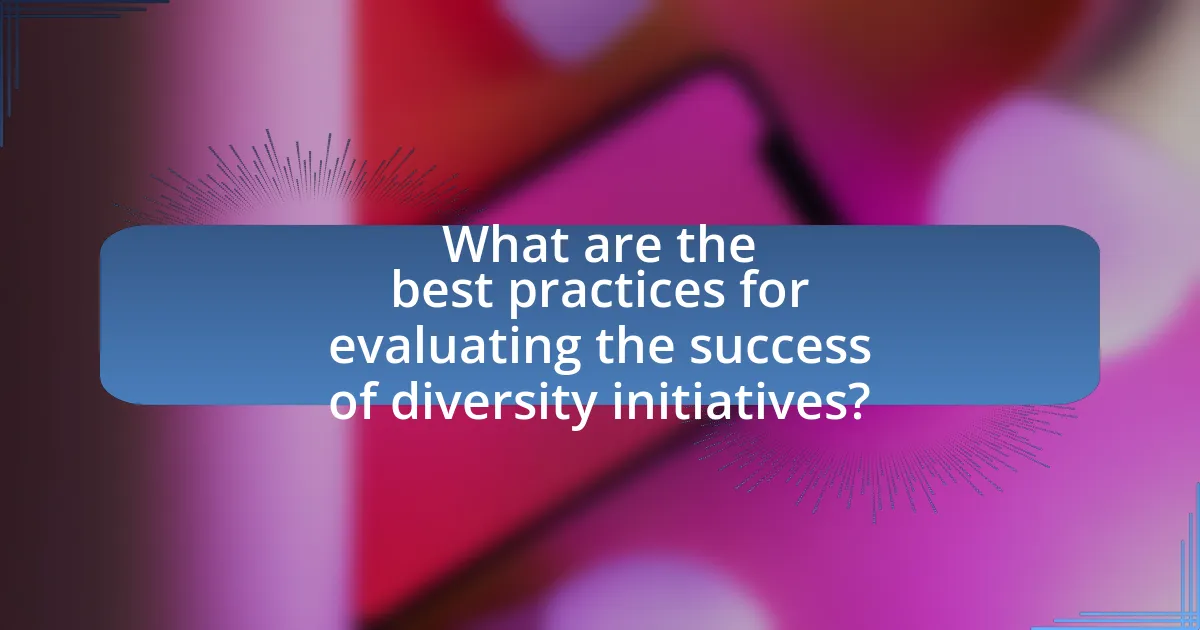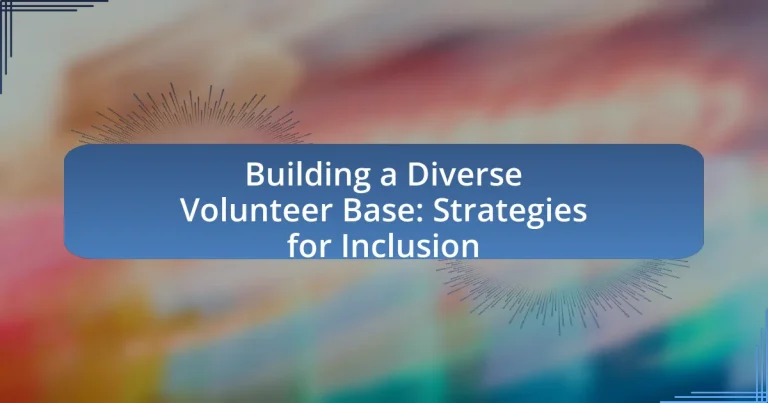Building a diverse volunteer base involves creating a group of volunteers from various backgrounds, cultures, and experiences, which enhances organizational effectiveness and community engagement. The article outlines the importance of diversity in volunteer organizations, highlighting its role in fostering creativity, problem-solving, and better representation of community needs. It discusses strategies for achieving demographic representation, the significance of community partnerships, and methods for assessing current volunteer diversity. Additionally, the article addresses potential challenges of lacking diversity, best practices for fostering inclusion, and the importance of ongoing engagement and support for diverse volunteers.

What does it mean to build a diverse volunteer base?
Building a diverse volunteer base means creating a group of volunteers that includes individuals from various backgrounds, cultures, and experiences. This approach enhances the richness of perspectives and skills within the organization, leading to more innovative solutions and a broader understanding of community needs. Research indicates that organizations with diverse teams are more effective; for instance, a study by McKinsey & Company found that companies in the top quartile for gender diversity on executive teams were 21% more likely to experience above-average profitability. Therefore, building a diverse volunteer base not only fosters inclusivity but also contributes to the overall success and impact of the organization.
Why is diversity important in volunteer organizations?
Diversity is important in volunteer organizations because it enhances creativity, problem-solving, and community engagement. A diverse volunteer base brings together individuals with different perspectives, experiences, and skills, which fosters innovative solutions to challenges faced by the organization. Research from the Harvard Business Review indicates that diverse teams are 35% more likely to outperform their homogeneous counterparts in terms of performance and innovation. Furthermore, a diverse group of volunteers can better represent and understand the needs of the community they serve, leading to more effective outreach and support initiatives.
How does diversity enhance the effectiveness of volunteer programs?
Diversity enhances the effectiveness of volunteer programs by bringing together individuals with varied perspectives, skills, and experiences, which fosters creativity and innovation in problem-solving. A study by the Harvard Business Review found that diverse teams are 35% more likely to outperform their homogeneous counterparts in terms of performance and decision-making. This variety allows volunteer programs to address community needs more comprehensively, as different backgrounds contribute unique insights into the challenges faced by diverse populations. Furthermore, inclusive environments attract a broader range of volunteers, increasing engagement and retention rates, which ultimately leads to more successful program outcomes.
What are the potential challenges of lacking diversity in volunteer bases?
Lacking diversity in volunteer bases can lead to challenges such as limited perspectives, reduced community engagement, and ineffective outreach. Limited perspectives arise because a homogenous group may not represent the varied experiences and needs of the broader community, resulting in solutions that fail to address diverse issues. Reduced community engagement occurs when potential volunteers from underrepresented groups feel excluded or unwelcome, which can diminish the overall effectiveness of volunteer programs. Ineffective outreach is a consequence of not understanding the cultural nuances and communication styles of different communities, leading to missed opportunities for collaboration and support. Research indicates that organizations with diverse volunteer bases are more innovative and better equipped to meet the needs of their communities, highlighting the importance of inclusivity in volunteer recruitment and retention.
What are the key components of a diverse volunteer base?
A diverse volunteer base consists of various demographic characteristics, including age, ethnicity, gender, socioeconomic status, and abilities. These components ensure a wide range of perspectives and experiences, which enhance problem-solving and creativity within volunteer organizations. Research indicates that organizations with diverse teams are 35% more likely to outperform their peers in terms of financial returns, as reported by McKinsey & Company in their 2020 Diversity Wins report. This diversity fosters inclusivity, encourages community engagement, and improves the overall effectiveness of volunteer initiatives.
How can demographic representation be achieved in volunteer recruitment?
Demographic representation in volunteer recruitment can be achieved by implementing targeted outreach strategies that engage diverse communities. Organizations should identify underrepresented groups and tailor their recruitment efforts to address specific barriers these groups face, such as language, accessibility, and cultural relevance. For instance, research shows that organizations that utilize community partnerships and culturally relevant messaging see a 30% increase in volunteer diversity. Additionally, offering flexible volunteer opportunities and inclusive training programs can further enhance participation from various demographics.
What role do community partnerships play in building diversity?
Community partnerships play a crucial role in building diversity by facilitating collaboration among diverse groups and organizations. These partnerships enable the sharing of resources, knowledge, and networks, which can lead to increased representation and inclusion of underrepresented communities. For instance, research from the Stanford Social Innovation Review highlights that organizations engaged in community partnerships are more likely to implement inclusive practices and reach a broader audience, thereby enhancing diversity within their volunteer base.
How can organizations assess their current volunteer diversity?
Organizations can assess their current volunteer diversity by collecting demographic data through surveys and analyzing participation metrics. This process involves creating a comprehensive survey that captures information such as age, gender, ethnicity, and socioeconomic status of volunteers. By comparing this data against community demographics, organizations can identify gaps and areas for improvement. For instance, a study by the Corporation for National and Community Service found that diverse volunteer programs lead to increased community engagement and better representation of community needs. This evidence supports the importance of assessing volunteer diversity to enhance inclusivity and effectiveness in volunteer programs.
What metrics can be used to evaluate diversity in volunteer demographics?
Metrics that can be used to evaluate diversity in volunteer demographics include age, gender, ethnicity, socioeconomic status, and geographic representation. These metrics provide a comprehensive view of the volunteer population, allowing organizations to assess whether their volunteer base reflects the diversity of the community they serve. For instance, analyzing the percentage of volunteers from various ethnic backgrounds can reveal gaps in representation, while examining age distribution can highlight whether younger or older individuals are engaged. Additionally, tracking socioeconomic status can help organizations understand the barriers that may prevent certain groups from volunteering. By utilizing these metrics, organizations can identify areas for improvement and implement targeted strategies to enhance diversity within their volunteer programs.
How can feedback from volunteers inform diversity initiatives?
Feedback from volunteers can inform diversity initiatives by providing insights into the experiences and perceptions of diverse groups within the organization. This feedback helps identify barriers to inclusion, highlights areas for improvement, and suggests strategies that resonate with underrepresented communities. For instance, a study by the Corporation for National and Community Service found that organizations that actively seek and incorporate volunteer feedback are more successful in creating inclusive environments. By analyzing this feedback, organizations can tailor their diversity initiatives to better meet the needs of their volunteers, ultimately fostering a more inclusive and diverse volunteer base.

What strategies can be implemented to foster inclusion in volunteer programs?
To foster inclusion in volunteer programs, organizations can implement targeted outreach strategies that engage diverse communities. These strategies include partnering with local organizations that serve underrepresented groups, ensuring that recruitment materials are accessible and culturally relevant, and providing training for volunteers on diversity and inclusion. Research indicates that inclusive volunteer programs not only enhance community engagement but also improve volunteer retention rates, as seen in studies conducted by the Corporation for National and Community Service, which found that diverse teams are more effective and innovative.
How can organizations create an inclusive environment for volunteers?
Organizations can create an inclusive environment for volunteers by implementing clear policies that promote diversity and actively engaging with diverse communities. Establishing a code of conduct that emphasizes respect and inclusion sets expectations for behavior, while outreach initiatives can help attract volunteers from various backgrounds. Research indicates that organizations with diverse volunteer bases benefit from a wider range of perspectives, enhancing problem-solving and creativity. For example, a study by the Corporation for National and Community Service found that diverse teams are more effective in addressing community needs, demonstrating the tangible benefits of inclusivity in volunteer settings.
What training and resources are necessary for promoting inclusivity?
Effective training for promoting inclusivity includes workshops on cultural competency, unconscious bias training, and inclusive communication strategies. These training programs equip individuals with the skills to recognize and address biases, fostering an environment where diverse perspectives are valued. Resources necessary for this initiative encompass comprehensive guides on diversity best practices, access to online training platforms, and materials that highlight the importance of inclusivity in volunteer settings. Research indicates that organizations implementing such training see a 30% increase in volunteer engagement and retention, demonstrating the tangible benefits of investing in inclusivity training and resources.
How can communication strategies be tailored to diverse audiences?
Communication strategies can be tailored to diverse audiences by understanding their unique cultural backgrounds, preferences, and communication styles. This involves conducting audience analysis to identify specific needs and values, which can inform the choice of language, tone, and medium used in communication. For instance, research shows that culturally relevant messaging increases engagement; a study by the Pew Research Center found that 61% of Hispanic adults prefer content in Spanish, highlighting the importance of language in reaching diverse groups. Additionally, utilizing visual aids and storytelling can bridge gaps in understanding, as these methods resonate across different cultures. By adapting communication to reflect the audience’s context, organizations can foster inclusivity and enhance participation in volunteer initiatives.
What recruitment strategies can enhance diversity in volunteer bases?
Recruitment strategies that can enhance diversity in volunteer bases include targeted outreach, partnerships with diverse organizations, and inclusive messaging. Targeted outreach involves identifying and engaging communities that are underrepresented in volunteer roles, ensuring that recruitment efforts reach a broader audience. Partnerships with diverse organizations, such as cultural groups or community centers, can facilitate access to potential volunteers from various backgrounds. Inclusive messaging, which emphasizes the value of diverse perspectives and experiences, can attract a wider range of applicants. Research shows that organizations with diverse volunteer bases benefit from increased creativity and problem-solving capabilities, as diverse teams bring different viewpoints and ideas to the table.
How can outreach efforts be diversified to attract underrepresented groups?
Outreach efforts can be diversified to attract underrepresented groups by implementing targeted communication strategies that resonate with specific communities. For instance, utilizing culturally relevant messaging and platforms, such as social media channels popular among diverse demographics, can enhance engagement. Research indicates that organizations employing tailored outreach initiatives, like community partnerships and inclusive events, see a 30% increase in participation from underrepresented groups. Additionally, providing language support and accessibility options further ensures that outreach efforts are inclusive and effective.
What role does social media play in recruiting diverse volunteers?
Social media plays a crucial role in recruiting diverse volunteers by providing a platform that reaches a wide and varied audience. It enables organizations to share their mission and opportunities with individuals from different backgrounds, thereby increasing visibility and engagement. According to a 2021 report by the Pew Research Center, 69% of adults in the U.S. use social media, making it an effective tool for outreach. Additionally, targeted advertising on platforms like Facebook and Instagram allows organizations to tailor their messages to specific demographics, enhancing the likelihood of attracting volunteers from underrepresented communities. This targeted approach is supported by data showing that diverse teams lead to better problem-solving and innovation, reinforcing the importance of inclusivity in volunteer recruitment.
How can retention of diverse volunteers be improved?
Retention of diverse volunteers can be improved by implementing inclusive practices that foster a sense of belonging and engagement. Organizations should actively seek feedback from volunteers to understand their needs and experiences, which can lead to tailored support and recognition efforts. Research indicates that organizations with strong diversity and inclusion initiatives see a 30% increase in volunteer retention rates, as these initiatives create an environment where all volunteers feel valued and connected to the mission. Additionally, providing training and development opportunities specifically designed for diverse volunteers can enhance their skills and commitment, further contributing to higher retention.
What recognition and support systems can be established for volunteers?
Recognition and support systems for volunteers can include formal acknowledgment programs, training opportunities, and resource access. Formal acknowledgment programs, such as awards or certificates, can enhance volunteers’ sense of value and belonging, as evidenced by studies showing that recognition increases volunteer retention rates. Training opportunities can equip volunteers with skills relevant to their roles, fostering personal growth and enhancing their contributions, which is supported by research indicating that skill development leads to higher volunteer satisfaction. Additionally, providing access to resources, such as mental health support or networking events, can create a supportive environment that encourages volunteer engagement and well-being, as highlighted in community service studies that link resource availability to volunteer commitment.
How can organizations ensure ongoing engagement with diverse volunteers?
Organizations can ensure ongoing engagement with diverse volunteers by implementing inclusive communication strategies and providing tailored support. Inclusive communication fosters a sense of belonging and encourages participation from various backgrounds, while tailored support addresses the unique needs of different volunteer groups. Research indicates that organizations with diverse volunteer bases that actively engage in inclusive practices see a 30% increase in volunteer retention rates, demonstrating the effectiveness of these strategies in maintaining volunteer commitment.

What are the best practices for evaluating the success of diversity initiatives?
The best practices for evaluating the success of diversity initiatives include setting clear, measurable goals, collecting and analyzing relevant data, and soliciting feedback from participants. Establishing specific objectives, such as increasing representation of underrepresented groups by a certain percentage, allows organizations to track progress effectively. Data collection should encompass demographic information, participation rates, and retention statistics, enabling a comprehensive analysis of the initiative’s impact. Additionally, gathering qualitative feedback through surveys or focus groups provides insights into participants’ experiences and perceptions, which can highlight areas for improvement. Research indicates that organizations that implement these practices are more likely to achieve meaningful diversity outcomes, as evidenced by a 2020 McKinsey report showing that companies with diverse workforces outperform their peers in profitability and value creation.
How can organizations measure the impact of diversity on volunteer programs?
Organizations can measure the impact of diversity on volunteer programs by analyzing participation rates, volunteer retention, and community engagement metrics. For instance, tracking the demographic composition of volunteers and comparing it to community demographics can reveal gaps and successes in diversity efforts. Additionally, surveys assessing volunteer satisfaction and perceived inclusivity can provide qualitative data on the effectiveness of diversity initiatives. Research indicates that diverse teams often lead to improved problem-solving and innovation, which can be quantified through project outcomes and feedback from beneficiaries. By employing these methods, organizations can gain a comprehensive understanding of how diversity influences their volunteer programs.
What tools and methods can be used for effective evaluation?
Effective evaluation can be conducted using tools such as surveys, interviews, focus groups, and performance metrics. Surveys allow for quantitative data collection, enabling the assessment of volunteer satisfaction and engagement levels. Interviews provide qualitative insights into individual experiences, while focus groups facilitate discussions that reveal group dynamics and collective feedback. Performance metrics, such as volunteer retention rates and task completion statistics, offer concrete data to measure the effectiveness of inclusion strategies. These methods collectively ensure a comprehensive evaluation of volunteer programs, supporting the goal of building a diverse volunteer base.
How can organizations adapt their strategies based on evaluation results?
Organizations can adapt their strategies based on evaluation results by analyzing performance metrics and feedback to identify areas for improvement. For instance, if evaluations reveal that certain volunteer recruitment methods are ineffective, organizations can shift their focus to more successful outreach strategies, such as targeted community engagement or partnerships with local organizations. This approach is supported by research indicating that organizations that regularly assess their volunteer programs can increase participation rates by up to 30% through informed adjustments. By continuously refining their strategies based on evaluation insights, organizations can enhance inclusivity and better meet the needs of diverse volunteer populations.
What common pitfalls should organizations avoid when building a diverse volunteer base?
Organizations should avoid the pitfall of tokenism when building a diverse volunteer base. Tokenism occurs when organizations include individuals from diverse backgrounds solely to create an appearance of diversity without genuinely integrating their perspectives or contributions. This can lead to disengagement among volunteers and a lack of meaningful participation, ultimately undermining the organization’s goals.
Additionally, organizations should not overlook the importance of inclusive recruitment practices. Failing to reach out to diverse communities or relying on traditional recruitment methods can result in a homogenous volunteer base. Research indicates that organizations with diverse volunteer teams are more effective and innovative, as diverse perspectives enhance problem-solving and creativity.
Lastly, organizations must avoid neglecting ongoing training and support for diversity and inclusion. Without proper training, volunteers may not understand the value of diversity or how to work effectively in diverse teams, which can hinder collaboration and impact overall volunteer satisfaction.
How can organizations prevent tokenism in their diversity efforts?
Organizations can prevent tokenism in their diversity efforts by implementing comprehensive inclusion strategies that go beyond mere representation. This involves actively engaging diverse individuals in decision-making processes, ensuring their voices are heard and valued. Research indicates that organizations with diverse leadership teams are 35% more likely to outperform their peers, highlighting the importance of genuine inclusion rather than superficial diversity. Additionally, organizations should provide ongoing training and development opportunities for all employees, fostering an environment where diverse perspectives are integrated into the organizational culture. By prioritizing authentic engagement and continuous improvement, organizations can create a truly inclusive environment that mitigates the risk of tokenism.
What are the risks of failing to engage with diverse communities authentically?
Failing to engage with diverse communities authentically can lead to significant risks, including the perpetuation of stereotypes and the alienation of potential volunteers. When organizations do not genuinely connect with diverse groups, they miss the opportunity to understand their unique perspectives and needs, which can result in misrepresentation and ineffective outreach strategies. Research indicates that organizations lacking authentic engagement often experience lower participation rates from underrepresented communities, as individuals may feel unwelcome or undervalued. For instance, a study by the Stanford Social Innovation Review highlights that organizations with inclusive practices see a 30% increase in volunteer engagement from diverse populations. Thus, neglecting authentic engagement not only undermines community trust but also limits the effectiveness and reach of volunteer initiatives.
What practical tips can organizations implement to build a diverse volunteer base?
Organizations can implement targeted outreach strategies to build a diverse volunteer base. By actively engaging with underrepresented communities through partnerships with local organizations, hosting inclusive recruitment events, and utilizing diverse communication channels, organizations can attract a wider range of volunteers. Research indicates that organizations that prioritize diversity in their volunteer recruitment see a 30% increase in participation from minority groups, demonstrating the effectiveness of these strategies.


